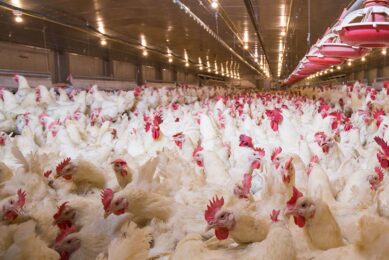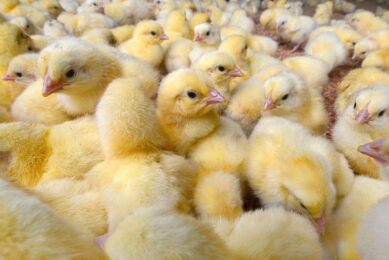Campylobacter, a European problem
![The temperature sensitivity of Campylobacter can be used successfully through physical intervention in in processing plants to reduce contamination levels, although this will increase processing costs. [Photo: World Poultry]](https://www.poultryworld.net/app/uploads/2021/04/001_898_rb-image-2670850-848x565.jpeg)
Campylobacter remains a major concern throughout Europe, causing multi-million cases of food-borne illness. Unfortunately, current knowledge of Campylobacter is not as advanced as one would wish and, towards this end, much more research is ongoing to better understand the aetiology of the infection and, subsequently, ways to combat it during production.
Since the 1988 announcement in the UK parliament that more than 80% of British eggs were contaminated with Salmonella Enteritidis, concerns about food safety have increased. A concerted control approach involving all levels of poultry production has reduced levels in Western Europe, knocking salmonellosis from its position as the most frequently reported cause for food-related gastroenteritis. This dubious honour has now passed to campylobacteriosis – with its major causes Campylobacter jejuni and Campylobacter coli — responsible for an estimated nine million cases per year in the EU, incurring costs, including medical intervention and lost working time, of around € 2.4 billion annually.
The bacterium
Campylobacter are Gram-negative, non-spore forming bacteria comprising of 23 identified species. S-shaped or spiral in structure, they require oxygen to survive, although some species can also grow anaerobically. C. jejuni and C. coli – the main cause of human campylobacteriosis– are thermophylic (thrive at high temperatures). They will not grow below 30°C. The optimum temperature for growth is 42°C: close to the body temperature of poultry. For this reason, poultry are considered the major reservoir for the bacteria, although it is found in wild birds, all food producing and companion animals and survives in the environment, provided it is moist. Most surface water sources that are contaminated by animal manure are contaminated with Campylobacter. Being thermophylic, Campylobacter will not multiply outside of the animal and will not further develop in meat or on the skin of chilled poultry. It is also susceptible to cold and will not survive freezing.
Effects in humans
Campylobacteriosis usually results in severe abdominal pains and diarrhoea, which can last for up to a week before recovery is made, although in certain cases it can result in hospitalisation. More than 100 deaths a year are attributed to campylobacteriosis each year in the UK alone, which is still lower than for Salmonella. In rare cases, it can also result in serious complications, such as Guillain-Barré syndrome, reactive arthritis, bacteraemia, inflammatory bowel disease and irritable bowel syndrome.
Poultry infection rates
The estimated incidences of human campylobacteriosis across the EU per 100,000 ranges from 30 in Sweden and Finland to 13,482 in Bulgaria and, in many cases, may be directly correlated with the incidence of Campylobacter infection in poultry. The level of direct poultry-related campylobacteriosis is approximately 20% to 30% of total cases, meaning that the majority are caused by alternative routes, such as direct animal contact and environmental sources. However, as chicken is also considered the major reservoir for indirect contamination coming from the environment, infections could still be further reduced by decreasing the incidence in commercial poultry flocks as a whole.
Headline problems
More recently, the Food Standards Agency (FSA) in the UK has carried out a survey of campylobacter contamination in whole chicken taken from major retail outlets and decided to ‘name and shame’ the companies by publishing the results. The survey found that 72.9% of all samples taken were contaminated to a degree and nearly 20% were highly contaminated with more than 1000 cfu/g of neck flap; nearly double the FSA’s 2015 target. Campylobacter have also been isolated on the outside of the package in a range of 4% to 13%, showing the potential for cross contamination in the processing plant and the potential risk from handling the finished product in the home. These data have also shown a seasonal pattern of contamination which increases in summer months—results that are in line with research undertaken in Denmark in 1999 – 2000 when contamination levels rose to 80% to 90%.
The upsurge of contamination and the negative publicity it has created have meant that many companies spend considerable sums trying to find a solution, ranging from enhancing biosecurity measures to testing physical interventions at processing plants. Unfortunately, unlike Salmonella, vaccination does not appear to be a viable option at this time. The stopping of thinning is also being studied by one of the major broiler producers in the UK, as is practised in some Scandinavian countries. In those countries, flocks are routinely tested before out-loading and any flocks found to be positive are slaughtered later in the day to reduce cross contamination in the plant; but also, importantly, the birds are then sold frozen. The desire for fresh, locally produced chicken throughout much of Europe has reduced frozen chicken purchases, exacerbating this situation.

Transmission
To date, the way in which flocks become infected is not fully understood. However, as the bacteria is not vertically transmitted, chicks test negative to the bacteria at placement. Often flocks become infected somewhere between 2 and 3 weeks of age, suggesting that perhaps there are incoming causes. Once contaminated, the spread within a flock is very rapid through faecal – oral transmission.
External intervention
The temperature sensitivity of Campylobacter can be used successfully through physical intervention in processing plants to reduce contamination levels, although this will increase processing costs. Two systems seem to be gaining some strength, with prototypes being tested in commercial plants using rapid surface chilling or rapid high temperatures applied by steam in conjunction with ultrasound.
Rapid surface chilling uses liquid nitrogen vapour in contact with the bird’s skin to freeze the outer layer of dermal cells, thereby shocking the bacteria, which die once the temperature rises again. Initial results from this system have shown a reduction of 1 log10 on skin contamination. Further refinements may increase this reduction to 1.5 – 2 log10, taking contamination levels to within the UK target levels. A 2 log10 reduction in the birds is estimated to reduce the rate of carcass contamination by approximately 70%. The high temperature intervention, developed by the Danish firm Sonasteam, incorporates ultrasound to open the pores of the skin before applying steam jets onto the skin. Again this is showing good reductions of 1 log10 in surface contaminations of Campylobacter. In the US and New Zealand, Campylobacter is well-controlled through the use of 20 to 30 ppm chlorine washes during processing. Due to concerns over the carcinogenic residues, this is not permitted in the EU, making Campylobacter more of a European problem.
While in-plant interventions may reduce the Campylobacter load sufficiently to meet FSA/EFSA standards, direct poultry infection still remains much lower than indirect poultry contamination. Efforts to reduce the environmental risks at production or farm level will be required. Three major ways of controlling Campylobacter include: improving on-farm biosecurity, stopping thinning of flocks and reducing the slaughter age to 28 days.
Biosecurity
As flocks tend to be negative when a day old but develop some contamination between 2 and 3 weeks of age, the pathogen may enter the house through one or more vectors. Increasing biosecurity could help reduce the rate of infection. Yet, as the vector is not well-understood, it is difficult to eliminate. Many vectors are considered to be potential causes of the disease, from flock to flock carryover, poor washing practices, farm staff, visitors, water and feed to flies and other insects.
Biosecurity alone does not seem to be able to provide a solution. Research has shown that contamination rates can be reduced by over 50% with stringent biosecurity measures, but not eliminated. Unfortunately, it is very difficult to maintain such high standards of biosecurity under commercial conditions, therefore a much lower reduction may be more realistic.
Thinning
Thinning, or partial depopulation during the growing cycle, poses a major threat to biosecurity with the introduction of many catchers and modular crates. It has been reported that thinned flocks are eight times more likely to be contaminated with Campylobacter than those having a single out-loading. This confirms the successful intervention carried out in some Scandinavian countries where thinning is no longer permitted. For many countries with significantly higher broiler production, the removal of thinning would place huge strains on the ability to meet production requirements in the short term, as well as increase production costs. This approach is currently being tested in one particular processing plant in the UK.
Another factor in regard to thinning is the increased stress levels being applied to all the birds, not only those being caught, due to the short-term feed removal, disruption and noise during the catching process itself. Stress increases the levels of catecholamine hormones and norepinephrine, known to potentiate bacterial growth and regulate the virulence of Campylobacter jejuni in humans. Norepinephrine supplies iron in the presence of transferrin and lactoferrin in iron-limited conditions, thus aiding the bacterial growth; and if the same is happening in chickens, this may help explain the sudden surge in levels of contamination following thinning.
Age of slaughter
While impractical due to market requirements, the reduction of the slaughter age to 28 days would dramatically reduce the levels of Campylobacter contamination. It has been shown that the risk factors of contamination increase every 10 days post-infection. In birds aged 8 to 9 weeks, the levels may subside; possibly the result of acquired immunity. The common slaughter age of 35 to 42 days in Europe means that birds are likely to be highly contaminated. Combined with the inability to use chemical washes post-evisceration and the fact that the consumer is reluctant to buy frozen poultry, it tends to make Campylobacter more of a European problem than a global problem.
References available upon request.
Join 31,000+ subscribers
Subscribe to our newsletter to stay updated about all the need-to-know content in the poultry sector, three times a week. Beheer
Beheer








 WP Admin
WP Admin  Bewerk bericht
Bewerk bericht